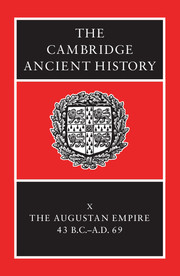4 - The expansion of the empire under Augustus
from PART I - NARRATIVE
Published online by Cambridge University Press: 28 March 2008
Summary
The contemporaries of Augustus delivered high praise for conquest and empire. The poet of the Aeneid has Jupiter forecast a Roman rule that will know no bounds of time or space, and Anchises' pronouncement from the underworld previews Augustus extending imperial power to the most remote peoples of the world. Livy characterizes his city as caput orbis terrarum and its people as princeps orbis terrarum populus. Horace asserts that the maiestas of the imperium stretches from one end of the world to the other.
The phrases echo sentiments and expressions of the Roman Republic. Militarism marked much of its history. And the exploits of the conqueror were envied, honoured and celebrated. Those precedents stimulated and helped shape the character of the Augustan years. Wars dominate the era, victories were repeatedly gained (or claimed), and the humbling of external foes became a prime catchword of the regime.
The successes of Augustus abroad suggest a drive to consolidate the empire, to create a united dominion under Roman rule. The princeps, it can be argued, conceived a broad-gauged military strategy, based on economy of force, which, through a combination of mobile troops and loyal dependencies, provided both for internal security and frontier stability.
Theoretical formulations in retrospect, however, fail to catch the dynamics of a volatile situation. And they slight the diversity of geographical, political, diplomatic and cultural considerations that faced Augustus in the vast expanse of the Roman world. One need not assume that the princeps had a structured blueprint for empire.
- Type
- Chapter
- Information
- The Cambridge Ancient History , pp. 147 - 197Publisher: Cambridge University PressPrint publication year: 1996
References
- 11
- Cited by



